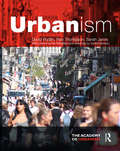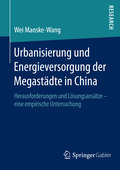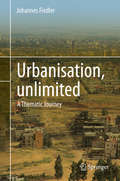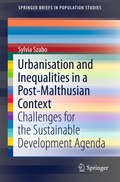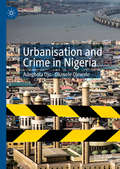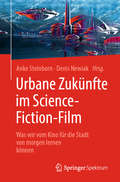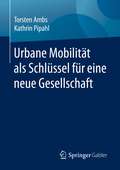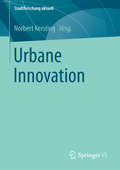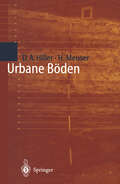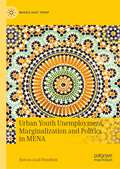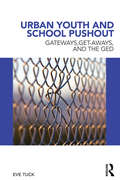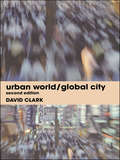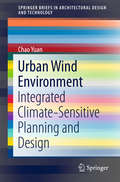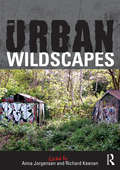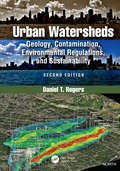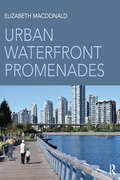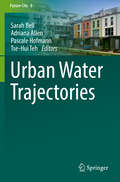- Table View
- List View
Urbanism
by Sarah Jarvis Rob Thompson David RudlinThe Academy of Urbanism was founded in 2006 with a mission to recognise, encourage and celebrate great places across the UK, Europe and beyond, and the people and organisations that create and sustain them. This book is a compendium of seventy five places that have been shortlisted as part of the Academy's annual awards scheme which covers great Places, Streets, Neighbourhoods, Towns and Cities. Included are 75 places shortlisted between 2009 and 2013. Each has been visited by a team of Academicians who have spent time in the place, talked to officials and local people and sought to understand what it is that makes them special and how they have achieved what they have achieved. The Academy also commissions a poem, a drawing and a figure ground plan to understand and interpret the place. David Rudlin, Rob Thompson and Sarah Jarvis have drawn on this treasure trove of material to tell the story of these 75 places. In doing so they have created the most comprehensive compendium of great urban places to have been published for many years.
Urbanisierung und Energieversorgung der Megastädte in China: Herausforderungen und Lösungsansätze – eine empirische Untersuchung
by Wei Manske-WangWei Manske-Wang analysiert den Zusammenhang zwischen der Urbanisierung im Rahmen der Stadtentwicklung und der zentralisierten Energieversorgungsstruktur in chinesischen Megastädten anhand einer empirischen Untersuchung, die auf Daten der vergangenen 35 Jahre zurückgreift. Aus den Ergebnissen der Studie entwickelt die Autorin eine Zukunftsprognose, welche durch eine Fallstudie für die Stadtentwicklung von Shanghai validiert wird. China spielt seit drei Jahrzehnten eine bedeutende Rolle für das Wachstum der Weltökonomie, gleichzeitig unterscheidet sich diese Volkswirtschaft in vielen Aspekten von den hierzulande bekannten Mustern. Die Autorin behandelt den gesamten Themenkomplex aus chinesischer Perspektive.
Urbanisation, unlimited: A Thematic Journey
by Johannes FiedlerIn a series of essays, the process of urbanisation – a human mega-trend acquiring unprecedented scale and speed as globalisation proceeds – is examined in the most diverse contexts and stages of development. Drawing on scientific references and identifying recurring themes like dispersion, privatisation and vitality, Fiedler devises the glossary for a cross-cultural understanding of the global urban system emerging. Images and anecdotal evidence reconnect these themes to local realities. The tone of the essays conveys a post-voluntarist attitude, derived from many years of professional experience – critical of both neoliberal practices and determinist ideas.To “condemn the reality” of global urbanization “is fruitless”, writes Johannes Fiedler in this unlimited view of a world of constant motion, subject no longer to just its planetary rotations, but also to the constant push and pull of its various populations, some of whose giant constructions shift the earth’s axis.From the foreword by Lars Lerup
Urbanisation and Inequalities in a Post-Malthusian Context: Challenges for the Sustainable Development Agenda (SpringerBriefs in Population Studies)
by Sylvia SzaboThe book examines contemporary urban challenges and opportunities within the context of the traditional Malthusian theory. The book reorients the classic Malthusian debate on population and food by focusing on global urbanisation and its consequences for peoples’ access to basic means of subsistence. Case studies from both developing and developed countries provide a comprehensive overview of the issues related to availability of food and water in an urban context. The book suggests that the concern for human survival is still relevant and can be exacerbated by rapid urbanisation, and that the negative impacts of urban processes require an increased attention of the international community as we enter the new Sustainable Development Goals era.
Urbanisation and Crime in Nigeria
by Adegbola Ojo Oluwole OjewaleThis book uses crime-science and traditional criminological approaches to explore urban crime in the rapidly urbanising country Nigeria, as a case study for urban crime in developing nations. In Africa’s largest democracy, rapid unmanaged growth in its cities combined with decaying public infrastructure mean that risk factors accumulate and deepen the potential for urban crime. This book includes a thorough explanation of key concepts alongside an examination of the contemporary configuration, dynamics, dimensions, drivers and potential responses to urban crime challenges. The authors also discuss a range of methodological techniques and applications that can be used, including spatial technologies to generate new data for analysis. It brings together history, theory, trends, patterns, drivers, repercussions and responses to provide a deep analysis of the challenges that confront urban dwellers. Urbanisation and Crime in Nigeria offers academics, researchers, governments, civil society organisations, citizens, and international partners a tool with which to engage in a serious dialogue about crime within cities, based on evidence and good practices from inside and outside sub-Saharan Africa.
Urbane Zukünfte im Science-Fiction-Film: Was wir vom Kino für die Stadt von morgen lernen können
by Ferdinando TerelleDieses Buch bietet eine außergewöhnliche Perspektive auf die nachhaltige, lebenswerte und humane Gestaltung urbaner Zukünfte, indem es sich dieser Herausforderung mit Blick auf das Science-Fiction-Kino sowie mit Bezügen zu Literatur, Architektur und Design nähert.Schon im Jahr 2050 sollen mehr als zwei Drittel aller Menschen in Ballungsräumen leben. Doch Großstädte laufen bereits heute Gefahr, an ihre Leistungsgrenzen zu stoßen: In den Megacities drohen Überbevölkerung, Verkehrschaos, Luftverschmutzung und Vereinsamung. Auf welche Weise werden solche zukünftig immer drängenderen Probleme in den fiktionalen Welten von Genreklassikern und aktuellen Blockbustern gelöst? Was lässt sich aus den fantastischen Zukunftsentwürfen zur Bewältigung urbaner Herausforderungen lernen?mediale und nachhaltige Großstadt-Architekturen New-Work-Designs und -KonzepteStrategien gegen gesellschaftliche SpaltungZu diesen und anderen Themen zeigen die Autoren eine Vielzahl von Ideen für die Stadtplanung der Zukunft auf und plädieren für das Nutzbarmachen kreativer Potenziale bei der Gestaltung lebenswerter Umgebungen.
Urbane Sicherheit: Migration und der Wandel kommunaler Sicherheitspolitik (Forum für Verwaltungs‐ und Polizeiwissenschaft)
by Hans-Jürgen Lange Christian Kromberg Anna RauDer Sammelband beleuchtet das Themenfeld Sicherheit im öffentlichen Raum aus unterschiedlichen Perspektiven von Wissenschaft, Polizei, Kommunen und Politik und bietet Rezipientinnen und Rezipienten neue Einblicke, Synergien und Lösungsansätze. Inhaltliche Schwerpunkte sind zum einen die Voraussetzungen und Herausforderungen urbaner Sicherheit im öffentlichen Raum, zum anderen der Zusammenhang von urbaner Sicherheit und Migration, der immer wieder im Mittelpunkt gesellschaftlicher und politischer Auseinandersetzungen steht. Außerdem werden die Konsequenzen der behandelten Entwicklungen für die Polizei selbst erörtert.
Urbane Resilienz gegenüber Stromausfällen in deutschen Großstädten (Stadtforschung aktuell)
by Alice KnaufEin langanhaltender, überregionaler Stromausfall führt in kurzer Zeit zu erheblichen Störungen in allen Sektoren kritischer Infrastrukturen mit schwerwiegenden Folgen für die Bevölkerung. Das vorliegende Buch gibt einen Überblick über Ausmaß und Ausrichtung der Maßnahmen, die von lokalen Katastrophenschutzämter deutscher Großstädte zur Stärkung der Urbanen Resilienz gegenüber dem Szenario getroffen werden. Mit Hilfe einer crisp-set Qualitative Comparative Analysis werden außerdem Faktoren ermittelt, die zu einem relativ ausgeprägten Aktivitätsniveau im deutschen Vergleich führen.
Urbane Mobilität als Schlüssel für eine neue Gesellschaft
by Torsten Ambs Kathrin PipahlDas Thema Urbane Mobilität rangiert sehr hoch in nahezu allen Gesellschaftsbereichen. So ist es nicht zwingend ein alleiniges Automobilthema, sondern betrifft Branchen wie Immobilien, Handel, Hospitality, Energie und Finanzen. Die Coronakrise hat nochmals unterstrichen, wie wichtig Mobilität im Sinne von Logistik und Fortbewegung für den wirtschaftlichen Wachstumsgedanken ist. Mobilität im Sinne von geistiger Beweglichkeit stellt einen wichtigen Kulturfaktor dar, Mobilität als Synonym für Freiheit.Das vorliegende Buch fokussiert Urbane Mobilität unter den Gesichtspunkten Technologie, neue Lebensformen, neue Wirtschaftssysteme und Gesellschaft. Mobilität muss nicht nur branchenübergreifend neu gedacht, sondern als ein kultureller Veränderungsprozess in seiner Gesamtheit verstanden werden. Urbane Mobilität vereint Themenwelten von Generationenkonflikt, über Nachhaltigkeit und Klimawandel bis hin zu einem neuen Politikverständnis. Unterstützt wird die Diskussion durch Beiträge von Experten aus unterschiedlichsten Branchen.
Urbane Innovation (Stadtforschung aktuell)
by Norbert KerstingDer Band beschreibt und analysiert Innovation im Bereich der Kommunalpolitik in Deutschland. Urbane Innovation beinhaltet Projekte und Programme, die bestehende lokalpolitische Strukturen und Prozesse zu verändern versuchen. Dabei konzentriert sich der Fokus auf urbane Projekte, politische und administrative Strukturen. Die Wertfreiheit des Begriffs Innovation bedeutet, dass die Analyse von ergebnisoffenen Veränderungen ausgeht. In den verschiedenen Innovationsfeldern werden Ziele vorgegeben und definiert. Die empirische Analyse dieser Innovationen muss aber sowohl die Zielsetzungen diskutieren als auch aufzeigen, inwieweit diese nachhaltig erreicht werden. Innovation beinhaltet insofern nicht per se einen urbanen Wandel. Erst die Ex Post-Analyse von Output, Outcome und Impact kann diesen nachweisen.
Urbane Globalisierung: Bedeutung und Wandel der Stadt im Globalisierungsprozess
by Hauke Jan RolfHauke Jan Rolf stützt sich auf eine stadtspezifische Betrachtungsweise und untersucht im Rahmen seiner Globalisierungskritik, inwieweit ökonomistische Ansätze im Globalisierungsdiskurs vorherrschen und sich auch in stadtbezogenen Analysen wie der Global City-Konzeption widerspiegeln. Er präsentiert eine tiefgreifende Studie der stadtspezifischen Globalisierungskonfiguration, die historische und kulturelle Bezüge herstellt, sozioökonomische Entwicklungsdivergenzen verschieden gearteter Städte berücksichtigt und politische Handlungsalternativen anbietet.
Urban Youth Unemployment, Marginalization and Politics in MENA (Middle East Today)
by Rawan Asali NuseibehThis book focuses on Arab youth marginalization along intersectional lines of gender, ethnicity and social class in four cities: Jerusalem, Amman, Cairo, and Tunis. The author explores how the political and economic climates in each city influence the life prospects of youth and uncovers their narratives around their aspirations, disappointments and life choices. Providing an interdisciplinary approach, the project will interest a wide range of audiences including graduate students, scholars, and policy makers in the fields of the Middle Eastern studies, political science, urban studies, and education.
Urban Youth and School Pushout: Gateways, Get-aways, and the GED (Critical Youth Studies)
by Eve TuckWinner of the 2013 American Educational Studies Association's Critics Choice Award! Recent efforts to reform urban high schools have been marked by the pursuit of ever-increasing accountability policies, most notably through the use of high-stakes standardized testing, mayoral control, and secondary school exit exams. Urban Youth and School Pushout excavates the unintended consequences of such policies on secondary school completion by focusing specifically on the use and over-use of the GED credential. Building on a tradition of critical theory and political economy of education, author Eve Tuck offers a provocative analysis of how accountability tacitly and explicitly pushes out under-performing students from the system. By drawing on participatory action research, as well as the work of indigenous scholars and theories, this theoretically and empirically rich book illustrates urban public schooling as a dialectic of humiliating ironies and dangerous dignities. Focusing on the experiences of youth who have been pushed out of their schools under the auspices of obtaining a GED, Tuck reveals new insights on how urban youth view accountability schooling, value the GED, and yearn for multiple, meaningful routes to graduation.
Urban Youth and School Pushout: Gateways, Get-aways, and the GED (Critical Youth Studies)
by Eve TuckWinner of the 2013 American Educational Studies Association's Critics Choice Award! Recent efforts to reform urban high schools have been marked by the pursuit of ever-increasing accountability policies, most notably through the use of high-stakes standardized testing, mayoral control, and secondary school exit exams. Urban Youth and School Pushout excavates the unintended consequences of such policies on secondary school completion by focusing specifically on the use and over-use of the GED credential. Building on a tradition of critical theory and political economy of education, author Eve Tuck offers a provocative analysis of how accountability tacitly and explicitly pushes out under-performing students from the system. By drawing on participatory action research, as well as the work of indigenous scholars and theories, this theoretically and empirically rich book illustrates urban public schooling as a dialectic of humiliating ironies and dangerous dignities. Focusing on the experiences of youth who have been pushed out of their schools under the auspices of obtaining a GED, Tuck reveals new insights on how urban youth view accountability schooling, value the GED, and yearn for multiple, meaningful routes to graduation.
Urban World/Global City
by David ClarkThis book identifies and accounts for the characteristics of the contemporary city and of urban society. It analyzes the distribution and growth of settlements and explores the social and behavioral characteristics of urban living. The latest theoretical and empirical developments and insights are synthesized and presented in an accessible and engaging way.This second edition has been extensively updated and referenced. Each chapter includes sets of learning objectives, annotated readings and topics for discussion. Well-illustrated throughout, it will be essential reading for students of geography, sociology and development studies and all who seek an understanding of how the urban world has evolved and how it will change in the twenty-first century.
Urban World/Global City
by David ClarkThis book identifies and accounts for the characteristics of the contemporary city and of urban society. It analyzes the distribution and growth of settlements and explores the social and behavioral characteristics of urban living. The latest theoretical and empirical developments and insights are synthesized and presented in an accessible and engaging way.This second edition has been extensively updated and referenced. Each chapter includes sets of learning objectives, annotated readings and topics for discussion. Well-illustrated throughout, it will be essential reading for students of geography, sociology and development studies and all who seek an understanding of how the urban world has evolved and how it will change in the twenty-first century.
Urban Wind Environment: Integrated Climate-Sensitive Planning and Design (SpringerBriefs in Architectural Design and Technology)
by Chao YuanIn the context of urbanization and compact urban living, conventional experience-based planning and design often cannot adequately address the serious environmental issues, such as thermal comfort and air quality. The ultimate goal of this book is to facilitate a paradigm shift from the conventional experience-based ways to a more scientific, evidence-based process of decision making in both urban planning and architectural design stage. This book introduces novel yet practical modelling and mapping methods, and provides scientific understandings of the urban typologies and wind environment from the urban to building scale through real examples and case studies. The tools provided in this book aid a systematic implementation of environmental information from urban planning to building design by making wind information more accessible to both urban planners and architects, and significantly increasing the impact of urban climate information on the practical urban planning and design. This book is a useful reference book to architectural postgraduates, design practitioners and planners, urban climate researchers, as well as policy makers for developing future livable and sustainable cities.
Urban Wildscapes
by Anna Jorgensen Richard KeenanUrban Wildscapes is one of the first edited collections of writings about urban ‘wilderness’ landscapes. Evolved, rather than designed or planned, these derelict, abandoned and marginal spaces are frequently overgrown with vegetation and host to a wide range of human activities. They include former industrial sites, landfill, allotments, cemeteries, woods, infrastructural corridors, vacant lots and a whole array of urban wastelands at a variety of different scales. Frequently maligned in the media, these landscapes have recently been re-evaluated and this collection assembles these fresh perspectives in one volume. Combining theory with illustrated examples and case studies, the book demonstrates that urban wildscapes have far greater significance, meaning and utility than is commonly thought, and that an appreciation of their particular qualities can inform a far more sustainable approach to the planning, design and management of the wider urban landscape. The wildscapes under investigation in this book are found in diverse locations throughout the UK, Europe, China and the US. They vary in scale from small sites to entire cities or regions, and from discrete locations to the imaginary wildscapes of children’s literature. Many different themes are addressed including the natural history of wildscapes, their significance as a location for all kinds of playful activity, the wildscape as ‘commons’ and the implications for landscape architectural practice, ranging from planting interventions in wildscapes to the design of the urban public realm on wildscape principles.
Urban Wildscapes
by Anna Jorgensen Richard KeenanUrban Wildscapes is one of the first edited collections of writings about urban ‘wilderness’ landscapes. Evolved, rather than designed or planned, these derelict, abandoned and marginal spaces are frequently overgrown with vegetation and host to a wide range of human activities. They include former industrial sites, landfill, allotments, cemeteries, woods, infrastructural corridors, vacant lots and a whole array of urban wastelands at a variety of different scales. Frequently maligned in the media, these landscapes have recently been re-evaluated and this collection assembles these fresh perspectives in one volume. Combining theory with illustrated examples and case studies, the book demonstrates that urban wildscapes have far greater significance, meaning and utility than is commonly thought, and that an appreciation of their particular qualities can inform a far more sustainable approach to the planning, design and management of the wider urban landscape. The wildscapes under investigation in this book are found in diverse locations throughout the UK, Europe, China and the US. They vary in scale from small sites to entire cities or regions, and from discrete locations to the imaginary wildscapes of children’s literature. Many different themes are addressed including the natural history of wildscapes, their significance as a location for all kinds of playful activity, the wildscape as ‘commons’ and the implications for landscape architectural practice, ranging from planting interventions in wildscapes to the design of the urban public realm on wildscape principles.
Urban Watersheds: Geology, Contamination, Environmental Regulations, and Sustainability, Second Edition
by Daniel T. RogersUnderstanding that the natural world beneath our feet is the point at which civilization meets the natural world is critical to the success of restoration and prevention efforts to reduce contaminant impacts and improve the global environment because of one simple fact – contaminants do not respect country borders. Contaminants often begin their destructive journey immediately after being released and can affect the entire planet if the release is in just the right amount, at just the right location, and at just the right time. Taking an interdisciplinary approach, Urban Watersheds, Geology, Contamination, Environmental Regulations, and Sustainability, Second Edition presents more than 30 years of research and professional practice on urban watersheds from the fields of environmental geology, geochemistry, risk analysis, hydrology, and urban planning. The geological characteristics of urbanized watersheds along with the physical and chemical properties of their common contaminants are integrated to assess risk factors for soil, groundwater, and air. This new edition continues to examine the urban environment and the geology beneath urban areas, evaluates the contamination that affects watersheds in urban regions, and addresses redevelopment strategies. Features of the Second Edition: Examines contaminants and the successes of environmental regulation worldwide and highlights the areas that need improvement Describes several advances in investigation techniques in urban regions that now provide a huge leap forward in data collection, resolution, and accuracy Explains the importance of understanding the geological and hydrogeologic environments of urban and developed regions Provides new and enhanced methods presented as a sustainability model for assessing risks to human health and the environment from negative human-induced contaminant impacts Includes a new chapter that surveys how environmental regulations have been successful or have failed at protecting the air, water, and land in urban areas Suitable for use as a textbook and as a professional practice reference, the book includes case studies on successful and unsuccessful approaches to contaminant remediation as well as practical methods for environmental risk assessment. PowerPoint® presentations of selected portions of the book are available with qualifying course adoption. Daniel T. Rogers is currently the Director of Environmental Affairs at Amsted Industries Inc. in Chicago, Illinois. His writings address environmental geology, hydrogeology, geologic vulnerability and mapping, contaminant fate and transport, urban geology, environmental site investigations, contaminant risk, brownfield redevelopment, and sustainability. He has taught geology and environmental chemistry at Eastern Michigan University and the University of Michigan.
Urban Watersheds: Geology, Contamination, Environmental Regulations, and Sustainability, Second Edition
by Daniel T. RogersUnderstanding that the natural world beneath our feet is the point at which civilization meets the natural world is critical to the success of restoration and prevention efforts to reduce contaminant impacts and improve the global environment because of one simple fact – contaminants do not respect country borders. Contaminants often begin their destructive journey immediately after being released and can affect the entire planet if the release is in just the right amount, at just the right location, and at just the right time. Taking an interdisciplinary approach, Urban Watersheds, Geology, Contamination, Environmental Regulations, and Sustainability, Second Edition presents more than 30 years of research and professional practice on urban watersheds from the fields of environmental geology, geochemistry, risk analysis, hydrology, and urban planning. The geological characteristics of urbanized watersheds along with the physical and chemical properties of their common contaminants are integrated to assess risk factors for soil, groundwater, and air. This new edition continues to examine the urban environment and the geology beneath urban areas, evaluates the contamination that affects watersheds in urban regions, and addresses redevelopment strategies. Features of the Second Edition: Examines contaminants and the successes of environmental regulation worldwide and highlights the areas that need improvement Describes several advances in investigation techniques in urban regions that now provide a huge leap forward in data collection, resolution, and accuracy Explains the importance of understanding the geological and hydrogeologic environments of urban and developed regions Provides new and enhanced methods presented as a sustainability model for assessing risks to human health and the environment from negative human-induced contaminant impacts Includes a new chapter that surveys how environmental regulations have been successful or have failed at protecting the air, water, and land in urban areas Suitable for use as a textbook and as a professional practice reference, the book includes case studies on successful and unsuccessful approaches to contaminant remediation as well as practical methods for environmental risk assessment. PowerPoint® presentations of selected portions of the book are available with qualifying course adoption. Daniel T. Rogers is currently the Director of Environmental Affairs at Amsted Industries Inc. in Chicago, Illinois. His writings address environmental geology, hydrogeology, geologic vulnerability and mapping, contaminant fate and transport, urban geology, environmental site investigations, contaminant risk, brownfield redevelopment, and sustainability. He has taught geology and environmental chemistry at Eastern Michigan University and the University of Michigan.
Urban Waterfront Promenades
by Elizabeth MacdonaldSome cities have long-treasured waterfront promenades, many cities have recently built ones, and others have plans to create them as opportunities arise. Beyond connecting people with urban water bodies, waterfront promenades offer many social and ecological benefits. They are places for social gathering, for physical activity, for relief from the stresses of urban life, and where the unique transition from water to land eco-systems can be nurtured and celebrated. The best are inclusive places, welcoming and accessible to diverse users. This book explores urban waterfront promenades worldwide. It presents 38 promenade case studies—as varied as Vancouver’s extensive network that has been built over the last century, the classic promenades in Rio de Janeiro, the promenades in Stockholm’s recently built Hammarby Sjöstad eco-district, and the Ma On Shan promenade in the Hong Kong New Territories—analyzing their physical form, social use, the circumstances under which they were built, the public policies that brought them into being, and the threats from sea level rise and the responses that have been made. Based on wide research, Urban Waterfront Promenades examines the possibilities for these public spaces and offers design and planning approaches useful for professionals, community decision-makers, and scholars. Extensive plans, cross sections, and photographs permit visual comparison.
Urban Waterfront Promenades
by Elizabeth MacdonaldSome cities have long-treasured waterfront promenades, many cities have recently built ones, and others have plans to create them as opportunities arise. Beyond connecting people with urban water bodies, waterfront promenades offer many social and ecological benefits. They are places for social gathering, for physical activity, for relief from the stresses of urban life, and where the unique transition from water to land eco-systems can be nurtured and celebrated. The best are inclusive places, welcoming and accessible to diverse users. This book explores urban waterfront promenades worldwide. It presents 38 promenade case studies—as varied as Vancouver’s extensive network that has been built over the last century, the classic promenades in Rio de Janeiro, the promenades in Stockholm’s recently built Hammarby Sjöstad eco-district, and the Ma On Shan promenade in the Hong Kong New Territories—analyzing their physical form, social use, the circumstances under which they were built, the public policies that brought them into being, and the threats from sea level rise and the responses that have been made. Based on wide research, Urban Waterfront Promenades examines the possibilities for these public spaces and offers design and planning approaches useful for professionals, community decision-makers, and scholars. Extensive plans, cross sections, and photographs permit visual comparison.
Urban Water Trajectories (Future City #6)
by Sarah Bell Adriana Allen Pascale Hofmann Tse-Hui TehWater is an essential element in the future of cities. It shapes cities’ locations, form, ecology, prosperity and health. The changing nature of urbanisation, climate change, water scarcity, environmental values, globalisation and social justice mean that the models of provision of water services and infrastructure that have dominated for the past two centuries are increasingly infeasible. Conventional arrangements for understanding and managing water in cities are being subverted by a range of natural, technological, political, economic and social changes. The prognosis for water in cities remains unclear, and multiple visions and discourses are emerging to fill the space left by the certainty of nineteenth century urban water planning and engineering.This book documents a sample of those different trajectories, in terms of water transformations, option, services and politics. Water is a key element shaping urban form, economies and lifestyles, part of the ongoing transformation of cities. Cities are faced with a range of technical and policy options for future water systems. Water is an essential urban service, but models of provision remain highly contested with different visions for ownership of infrastructure, the scale of provision, and the level of service demanded by users. Water is a contentious political issue in the future of cities, serving different urban interests as power and water seem to flow in the same direction. Cities in Africa, Asia, Australia, Europe and South America provide case studies and emerging water challenges and responses. Comparison across different contexts demonstrates how the particular and the universal intersect in complex ways to generate new trajectories for urban water.
